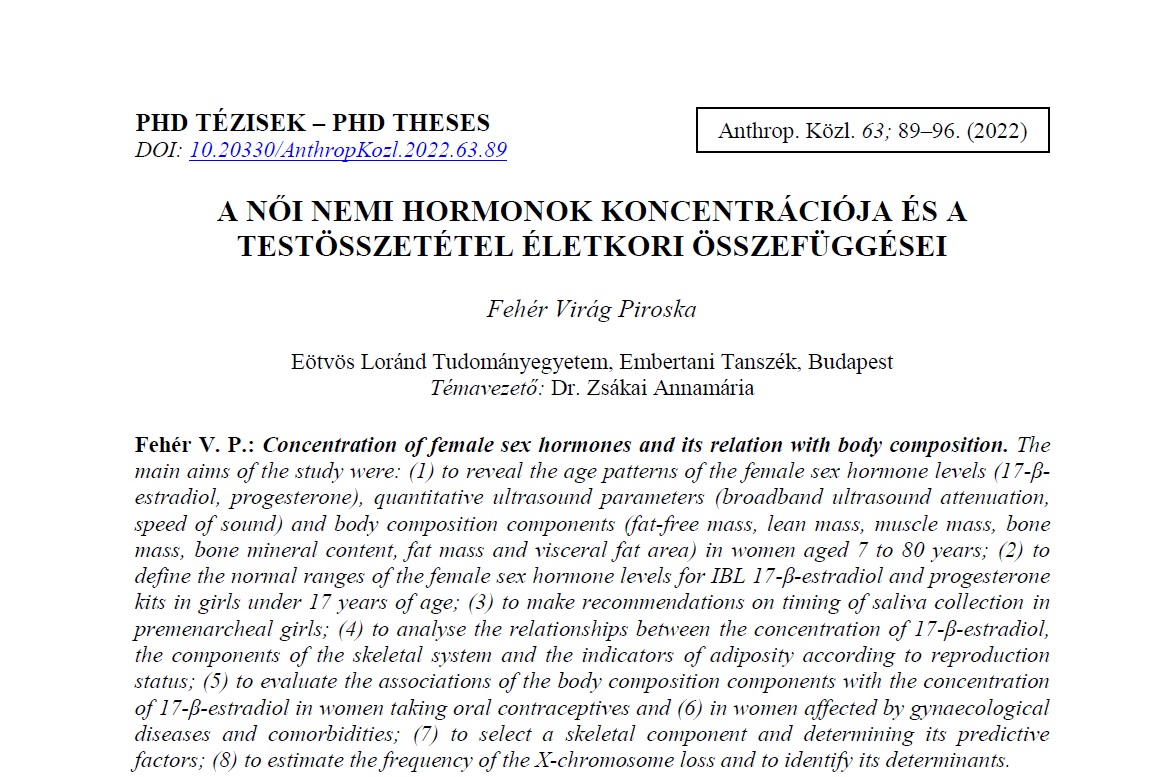A női nemi hormonok koncentrációja és a testösszetétel életkori összefüggései
Absztrakt
The main aims of the study were: (1) to reveal the age patterns of the female sex hormone levels (17-β-estradiol, progesterone), quantitative ultrasound parameters (broadband ultrasound attenuation, speed of sound) and body composition components (fat-free mass, lean mass, muscle mass, bone mass, bone mineral content, fat mass and visceral fat area) in women aged 7 to 80 years; (2) to define the normal ranges of the female sex hormone levels for IBL 17-β-estradiol and progesterone kits in girls under 17 years of age; (3) to make recommendations on timing of saliva collection in premenarcheal girls; (4) to analyse the relationships between the concentration of 17-β-estradiol, the components of the skeletal system and the indicators of adiposity according to reproduction status; (5) to evaluate the associations of the body composition components with the concentration of 17-β-estradiol in women taking oral contraceptives and (6) in women affected by gynaecological diseases and comorbidities; (7) to select a skeletal component and determining its predictive factors; (8) to estimate the frequency of the X-chromosome loss and to identify its determinants.
In the doctoral dissertation: (1) the age patterns of the female sex hormone levels, quantitative ultrasound parameters and body composition components have been revealed in women aged 7 to 80 years (n=975); (2) the normal ranges of the female sex hormone levels in girls under 17 years of age have been defined; (3) recommendations on timing of saliva collection in premenarcheal girls have been made; (4) the relationships between the concentration of 17-β-estradiol, the components of the skeletal system and the indicators of adiposity according to reproduction status have been analysed; (5) the associations of the body composition components with the concentration of 17-β-estradiol in women taking oral contraceptives and (8) in women affected by gynaecological diseases, disorders and comorbidities have been evaluated; (7) a skeletal component has been selected and its predictive factors have been determined; (8) the frequency of the X chromosome loss has been estimated and its determinants have been identified (n=50).
Osteoporosis, obesity and infertility are seemingly independent diseases. The results of the doctoral dissertation revealed that one of their common points is abdominal obesity. In premenopausal women concentration of 17-β-estradiol was negatively correlated with visceral fat area. Obese premenopausal women had lower level of 17-β-estradiol than non-obese women. As new results we could confirm that the increased WHR reduced the frequency of cells with normal karyotype; malnutrition, increased WHR and excessive visceral fat area increased the risk of developing osteoporosis in premenopausal women; overweight or obese premenopausal women, women with increased WHR, excessive visceral fat area had smaller relative bone mass and smaller relative BMC than women having normal BMI, WHR and visceral fat area; in premenopausal women increased WHR had a negative effect on the amount of relative bone mass.
The results of the study highlighted the importance of WHR both as a risk factor of osteoporosis and as a risk factor of the X-chromosome loss. WHR is easy to measure, inexpensive and non-invasive way to be informed about the distribution of body fat. Based on our results we can recommend taking the reproductive status, WHR, the amount of muscle mass and the level of physical activity into FRAX® calculator.
Hivatkozások
Annár, D.S., Fehér, V.P., Ince, S., Madarasi, A., Muzsnai, Á., Kékesi, A., Zsákai, A. (2021): A citológiai öregedés életkori mintázatának és szekuláris trendjének vizsgálata felnőtt nők körében. Anthropologiai Közlemények, 62: 69–76. DOI: https://doi.org/10.20330/AnthropKozl.2021.62.69
Annár, D., Fehér, P., Madarasi, A., Mascie‐Taylor, N., Kékesi, A., Kalabiska, I., Muzsnai, Á., Zsákai, A. (2022): Body structural and cellular ageing of women with low socioeconomic status in Hungary. American Journal of Human Biology, 34(3): e23662. DOI: https://doi.org/10.1002/ajhb.23662
Cole, T.J., Bellizzi, M.C., Flegal, K.M., Dietz, W.H. (2000): Establishing a standard definition for child overweight and obesity worldwide: international survey. BMJ, 320(7244): 1240–1243. DOI: https://doi.org/10.1136/bmj.320.7244.1240
Cole, T.J., Flegal, K.M., Nicholls, D., Jackson, A.A. (2007): Body mass index cut offs to define thinness in children and adolescents: international survey. BMJ, 335(7612): 194. DOI: https://doi.org/10.1136/bmj.39238.399444.55
Drinkwater, D.T., Ross W.D. (1980): Anthropometric fractionation of body mass. In: Kinanthropometry II. Univ. Park Press, Baltimore, 178–189.
Fehér, V.P., Annár, D., Zsákai, A., Bodzsár, É. (2020): The body composition analysis as a complementary tool in the screening of bone structural abnormalities. Anthropologischer Anzeiger, 77: 161–171. DOI: https://doi.org/10.1127/anthranz/2020/1136
Martin, R., Saller, K. (1975): Lehrbuch der anthropologie I. Stuttgar. Germany: Fisher.
Salari, N., Ghasemi, H., Mohammadi, L., Rabieenia, E., Shohaimi, S., Mohammadi, M. (2021): The global prevalence of osteoporosis in the world. Journal of Orthopaedic Surgery and Research, 16(1): 1–20. DOI: https://doi.org/10.1186/s13018-021-02772-0
Weiner, J.E., Lourie, J.A. (1969): Human Biology. A Guide to Field Methods. Blackwell, Oxford.
World Health Organization (2000): Obesity: preventing and managing the global epidemic. No. 894. Geneva.
World Health Organization (2008): Waist circumference and waist-hip ratio. A report of a WHO expert consultation, Geneva.
World Health Organization (2020): Infertility. https://www.who.int/news-room/fact-sheets/detail/infertility
World Health Organization (2021): Obesity and overweight. https://www.who.int/news-room/fact-sheets/detail/obesity-and-overweight
Yuji, M. (2002): Examination Committee of Criteria for’Obesity Disease’in Japan; Japan Society for the Study of Obesity. Circulation, 66: 987–992. DOI: https://doi.org/10.1253/circj.66.987
Zsákai, A., Fehér, V. P., Annár, D., Bodzsár, É. (2017): A gyermek-és serdülőkori kövérség meghatározásának testzsírosság mutatóira épülő, új hazai határértékei. Anthropologiai Közlemények, 58: 63–74. DOI: https://doi.org/10.20330/AnthropKozl.2017.58.63
Zsákai, A., Mascie-Taylor, N., Bodzsár, É. B. (2015): Relationship between some indicators of reproductive history, body fatness and the menopausal transition in Hungarian women. Journal of Physiological Anthropology, 34(1): 1–12. DOI: https://doi.org/10.1186/s40101-015-0076-0




